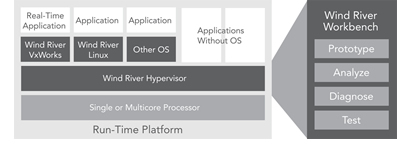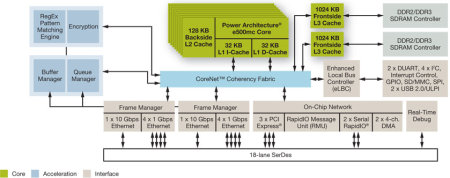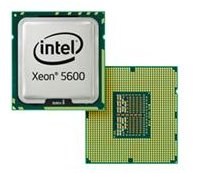Wind River Hypervisor adds QorIQ, Xeon 5600 support
Oct 25, 2010 — by Eric Brown — from the LinuxDevices Archive — 2 viewsWind River has upgraded its embedded virtualization software to support two major multicore processor platforms. Wind River Hypervisor 1.2 adds support for the Intel Xeon 5600 series and Freescale's QorIQ P2 and P4 system-on-chips (SoCs), including the P4080 model, and offers a new device management layer and automated software upgrades, says the company.
Wind River Hypervisor is a virtualization solution designed from the ground up for embedded technology (see farther below for more technical background). The software is closely integrated with the company's VxWorks real-time operating system (RTOS) and Wind River Linux distribution. The latter was recently upgraded to version 4. Wind River Hypervisor is also said to be highly optimized and integrated with the Wind River Workbench Eclipse IDE and the Wind River Test Management test automation framework.
Wind River Hypervisor first shipped in June 2009 with generic support for Intel x86 and PowerPC processors. The embedded virtualization software was revisedd in February of this year in a 1.1 version that specifically added support for the Core i5/i7 and Xeon 5500 processors made by its owner, Intel Corp. Version 1.1 also enabled new inter-virtual machine communications, and debuted virtual board debugging via the newly revised and integrated Wind River On-Chip Debugging.

Wind River Hypervisor, simplified architecture
Now, Wind River is offering targeted Hypervisor support for the Intel Xeon 5600, as well as the Power PC-based Freescale QorIQ P2 and P4, enabling members of either processor line to run unmodified guest operating systems.
Cross-platform enhancements to Wind River Hypervisor 1.2 include a flexible device management layer, which offers fine-grained tuning of device access and sharing, "thereby delivering flexibility with maximum performance," says Wind River. In addition, Wind River Hypervisor provides an automated software upgrade feature for updating operating systems running inside the software's virtual machines, says the company.
Freescale QorIQ P2 and P4
Wind River Hypervisor 1.2 offers its first targeted support for Freescale's e500mc PowerPC core and QorIQ P2 and P4 SoC families. It also offers more specific support for the QorIQ P4080 SoC. This includes support for the virtualization hardware assist offered by the processor core, the P4080's multiple memory buses, as well as its Data Path Acceleration Architecture, says Wind River.
Freescale announced the QorIQ line of SoCs in June 2008. The pin- and software-compatible successors to Freescale's PowerQUICC line of network processors range from one to eight PowerPC e500 cores. The single-core P101 runs at 400MHz on only four Watts while the eight-core P4080 runs at 1.5GHz on a relatively modest 30 Watts. The P2 QorIQ models — the single-core P2010 and dual-core P2020 — are both clocked at 1.2GHz.

QorIQ P4080 block diagram
(Click to enlarge)
The P4080 supports virtualization via a hypervisor based on Virtutech's Simics technology. Intel acquired Virtutech in February and said Simics would be offered as a standalone product by Wind River. It is unclear to what extent, if any, Simics and Wind River Hypervisor have been integrated, but the Virtutech expertise no doubt came in handy in unlocking the P4080.
Virtutech Simics provides a hybrid simulation environment that is said to offer a "controlled, deterministic, and fully reversible" environment for the development, debugging and benchmarking of software in embedded multicore environments.
In December of last year, Freescale added the QorIQ P1012 and dual-core P1021 SoCs to the QorIQ family.This June, meanwhile, the chipmaker announced new P3 and P5 QorIQ processor families within the platform, as well its first 64-bit PowerPC core, clockable to 2.5GHz. The single-core QorIQ P5010 and dual-core P5020 processors offer the 64-bit e5500 core, which uses 30 Watts while clocked at 2.2GHz, and the QorIQ P3041 integrates four e500 cores, using 12 Watts at 1.5GHz, says Freescale.
Intel Xeon 5600 background
Intel, meanwhile, announced its 32nm-fabricated Xeon 5600 processors in March as the next generation upgrade to the Xeon 5500. In addition to introducing a dozen  enterprise-class versions of the Xeon 5600, Intel debuted four models with seven-year lifecycle support, targeting embedded applications and "built for thermally constrained and robust communications environments."
enterprise-class versions of the Xeon 5600, Intel debuted four models with seven-year lifecycle support, targeting embedded applications and "built for thermally constrained and robust communications environments."
The Xeon E5645 and Xeon L5638 each provide six cores and 12 threads. The Xeon E5645 has a 2.4GHz clock speed and an 80 Watt TDP, and the Xeon L5638 offers a 2.0GHz clock speed and 60 Watt TDP, according to Intel.
The two quad-core embedded entrants include the Xeon E5620 and L5618. The E5620 has a 2.4GHz clock speed and 80 Watt TDP, while the L5618 has a 1.86GHz clock speed and 40 Watt TDP, Intel says. The quad-core versions offer AES-NI (advanced encryption standard new instructions) and TXT (trusted execution technology).
AES-NI is a new set of instructions that accelerates AES performance, improving performance for disk and database encryption plus secure Internet transactions, the company says. TXT provides a more secure platform launch environment, and protection for applications that move between virtualized servers, adds Intel.
ARM support due in 2011, but whither MIPS and Octeon?
Wind River now says that it will add multicore ARM support to Wind River Hypervisor in 2011. This would likely include the multicore Cortex-A9 processor architecture.
Initially, the company had said it would offer MIPS support in the future. The first likely MIPS candidate would be Cavium Networks' Octeon processor family, considered to be the third major multicore embedded platform along with Freescale's Power architecture QorIQ line and Intel's Core and Xeon processors.
Wind River made no mention of MIPS in today's announcement, although it says it will support Cavium multicore processors with a Wind River Linux 4 board support package. Wind River Linux 4 BSPs are also planned for SoCs from Freescale, Intel, NetLogic Microsystems, and Texas Instruments.
Rival MontaVista Software, which is now owned by Cavium, recently upgraded its MontaVista Linux Carrier Grade Edition (CGE) to a version 6.0 that offers several features that specifically target the Octeon line. CGE 6.0 also introduced a multicore resource management scheme that offers somewhat similar virtualization capabilities to Wind River Hypervisor, but directly built into the core distribution.
Wind River background
Wind River Hypervisor is designed to enable embedded developers replace multiple boards or CPUs with a single board or CPU, thereby saving on cost and power consumption, says Wind River. Developers can also use the technology to create devices that leverage multiple OSes, and reduce complexity when integrating multicore processors.
The technology is billed as a "Type-1" hypervisor supporting real-time features including fast performance, low latency, determinism, and minimal footprint. Wind River Hypervisor offers protection between OSes and cores, and is capable of starting, stopping, and reloading OSes for increased reliability, says the company. The technology is said to support Symmetric Multiprocessing (SMP), Asymmetric Multiprocessing (AMP) and supervised AMP architectures.
Wind River spins multicore adoption service
In a related announcement, Wind River Professional Services has launched a Wind River Multi-Core Adoption Package that helps customers develop "a reliable path to multicore," says the company. The service is said to include two consultative elements: the Multi-core Platform Architecture Study and Multi-core Platform Implementation Services.
Stated Mark Hermeling, product line manager for embedded virtualization at Wind River, "Adoption of multicore and embedded virtualization offers opportunities to leverage existing software in the form of legacy, commercial off-the-shelf (COTS) and open source as well as improve the reliability of systems. We're seeing a notable increase in virtualization demand across many of our key embedded market segments."
Availability
Wind River Hypervisor 1.2 and the Wind River Multi-core Adoption Package are available now. More information about Wind River Hypervisor may be found here. More about Wind River Professional Services and the Wind River Multi-core Adoption Package may be found here.
This article was originally published on LinuxDevices.com and has been donated to the open source community by QuinStreet Inc. Please visit LinuxToday.com for up-to-date news and articles about Linux and open source.